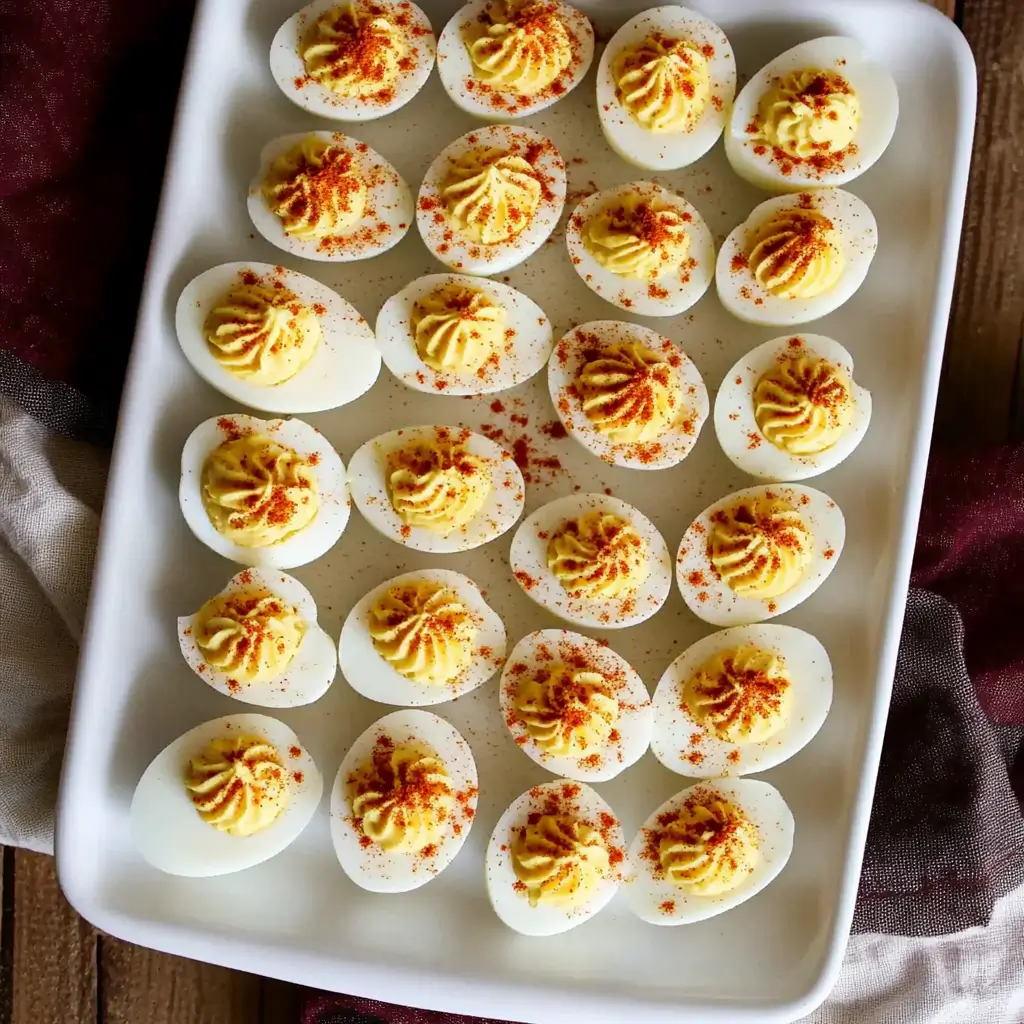There’s something undeniably charming about Traditional Deviled Eggs. They’re the kind of appetizer that instantly makes a table feel festive, whether it’s for Easter brunch, a family picnic, Thanksgiving dinner, or just a casual gathering on a sunny afternoon. Simple yet elegant, these bite-sized beauties carry a nostalgic warmth, often linked with cherished family traditions and celebratory moments. They’re the kind of food that, once placed on the table, seems to vanish almost instantly—proof of their universal appeal.
I first encountered this particular deviled eggs recipe at my mother-in-law’s house during a New Year’s get-together. She had a way of preparing them that felt both classic and uniquely hers, a combination of creamy, tangy, and just a little punchy thanks to the mustard and vinegar. Over the years, I’ve adapted her recipe ever so slightly to suit my preferences while keeping its original soul intact. Now, it’s one of my go-to dishes whenever we’re hosting friends, bringing something to a potluck, or simply craving a little nostalgic comfort food.
This traditional recipe is all about balance—richness from the egg yolks and mayonnaise, brightness from mustard and vinegar, and that final touch of smoked paprika that brings it all together. If you’ve never made deviled eggs before, don’t worry. You’ll be surprised at how easy and satisfying they are to prepare. And if you’re already a deviled egg fan, I think this version might just become your new favorite.
Why You’ll Love This Recipe
There are so many reasons to love Traditional Deviled Eggs, and this recipe checks all the boxes. First and foremost, it’s incredibly simple. With just a handful of ingredients—most of which you probably already have in your kitchen—you can create a dish that’s both flavorful and impressive.
One of the biggest draws is how easy they are to prepare. From boiling the eggs to mashing the yolks and assembling the final bites, everything comes together in under 30 minutes. Even if you’re new to cooking, you’ll find this recipe straightforward and stress-free. The steps are easy to follow, and there’s plenty of room for creativity if you feel like adding your own twist.
Lastly, they’re make-ahead friendly. You can boil the eggs and prepare the filling in advance, then assemble them right before serving. This makes hosting so much easier and gives you more time to enjoy the moment.
Health Benefits
While Traditional Deviled Eggs are often thought of as a party snack, they can actually offer some nutritional benefits, especially when made with wholesome ingredients. Eggs themselves are an excellent source of high-quality protein, which is essential for muscle repair and maintaining healthy body functions. Each egg contains about six grams of protein, along with essential vitamins like B12, D, and A.
The yolks are rich in healthy fats and also contain choline, a nutrient that supports brain function and development. Choline is particularly important for pregnant women and those looking to boost cognitive health. When eaten in moderation, the fat in egg yolks can also help you feel full and satisfied, making deviled eggs a great option for controlling appetite during busy event days.
Mayonnaise, while often seen as an indulgent ingredient, can be substituted with healthier alternatives like Greek yogurt or avocado for added nutrients and fewer calories. Greek yogurt boosts the protein content even further and provides probiotics that support gut health.
So, while deviled eggs may be considered a comfort food, they also offer a solid nutritional profile when made thoughtfully. Whether you’re looking for a protein-packed snack, a low-carb appetizer, or a tasty way to add more nutrients to your holiday spread, this recipe fits the bill.
Preparation Time, Servings, and Nutritional Information
One of the reasons this traditional deviled eggs recipe is so beloved is how quickly it comes together. You don’t need to spend hours in the kitchen to deliver a dish that’s both beautiful and delicious.
Preparation Time:
- Boiling and peeling the eggs: 15–20 minutes
- Preparing the filling: 10 minutes
- Assembling the deviled eggs: 10 minutes
- Total Time: Approximately 30–40 minutes
Servings:
- This recipe yields 24 deviled egg halves (12 whole eggs), which can serve about 8–12 people depending on the setting and what other dishes are being served.
Nutritional Information (per serving of 2 halves):
- Calories: 120
- Protein: 6g
- Carbohydrates: 1g
- Fat: 10g
- Fiber: 0g
- Sugar: 0g
- Cholesterol: 190mg
- Sodium: 180mg
Ingredients List
Here’s what you’ll need to make this classic deviled egg recipe. Each ingredient plays a key role in building that perfectly balanced flavor.
- Eggs (12 large)
- Mayonnaise (½ cup)
- Yellow Mustard (2 teaspoons)
- White Vinegar (1 teaspoon)
- Salt (to taste)
- Black Pepper (to taste)
- Smoked Paprika (for garnish)
Optional Add-Ins:
- Chopped pickles or relish for a bit of crunch and tang
- Fresh herbs like chives, parsley, or dill for color and freshness
- Crumbled turkey bacon for texture and a savory kick
Step-By-Step Cooking Instructions
Making Traditional Deviled Eggs is a straightforward process, but a few extra tips and tricks can make a big difference in the final result. Follow these steps for deviled egg perfection.
Boil the Eggs
Start by placing your eggs in a single layer in a large saucepan. Cover them with cold water, making sure the water is at least an inch above the eggs. Bring the water to a gentle boil over medium-high heat. Once the water reaches a rolling boil, turn off the heat, cover the pot, and let the eggs sit for 10–12 minutes. This method helps prevent the dreaded green ring around the yolks.
After the eggs have finished cooking, transfer them immediately to a bowl of ice water. Let them sit in the ice bath for at least 10 minutes. This stops the cooking process and makes peeling much easier.
Peel the Eggs
Once the eggs are cool, gently crack them all over and peel them under running water. If you find the shells difficult to remove, rolling the eggs on the counter before peeling can help loosen the shell.
Slice and Separate Yolks
Slice each egg in half lengthwise. Carefully pop out the yolks and place them in a medium bowl. Set the whites aside on a serving tray or deviled egg plate.
Make the Filling
Using a fork, mash the yolks until they’re finely crumbled. Add the mayonnaise, mustard, and vinegar. Stir until the mixture is smooth and creamy. Taste and season with salt and pepper. If the mixture is too thick, you can add a small splash of milk, water, or more mayo to loosen it up.
Fill the Egg Whites
You have a couple of options for filling the egg whites. The simplest method is using a spoon to gently scoop the yolk mixture into each egg white half. For a more polished look, transfer the filling to a piping bag fitted with a star tip and pipe it into the egg whites. If you don’t have a piping bag, a resealable plastic bag with the corner snipped off works just as well.
Garnish and Serve
Sprinkle the tops with smoked paprika. This not only adds color but also brings a smoky flavor that complements the creamy filling beautifully. You can also garnish with chopped chives, parsley, or a slice of olive if you like.
Chill or Serve
You can serve the deviled eggs immediately, or cover and refrigerate them until you’re ready. They hold up well in the fridge for up to two days before serving.
How to Serve
Traditional Deviled Eggs are versatile and can be served in many ways depending on the occasion. Whether you’re hosting a formal holiday dinner or a casual weekend brunch, they fit right in. Arrange them on a platter, ideally one with indentations to keep them from sliding around. If you don’t have a special deviled egg tray, line a regular plate with lettuce leaves to keep them steady.
You can serve them chilled straight from the fridge or at room temperature if they’ve just been assembled. For an elevated look, garnish with finely chopped herbs or a small slice of pickle on top. If you’re bringing them to a potluck, consider transporting the egg whites and filling separately and assembling on-site to maintain freshness and presentation.
They also make a great addition to grazing boards, charcuterie spreads, or buffet tables. You can mix in a few flavor variations—like spicy, herbed, or bacon-topped versions—for a little variety and visual interest. Deviled eggs always add that classic, comforting touch to any meal.
Pairing Suggestions
Traditional Deviled Eggs pair well with a wide variety of dishes and drinks. Their creamy, tangy flavor complements fresh, crunchy textures and light, acidic flavors, making them an excellent match for many sides.
Serve them with a crisp green salad dressed in lemon vinaigrette or alongside fresh vegetable sticks like cucumber, carrots, and celery. For heartier meals, they go well with grilled meats, roasted chicken, or baked fish. Their richness is balanced beautifully by sides that offer contrast in texture and taste.
As part of a brunch spread, pair them with mini sandwiches, croissants, fruit salads, and freshly squeezed juices. During holidays like Thanksgiving or Eid, place them on the appetizer table with stuffed grape leaves, potato wedges, or meatballs.
Their flavor is adaptable, so whether you’re going light and fresh or hearty and savory, deviled eggs will easily find their place on the menu.
Storage, Freezing & Reheating Instructions
Deviled eggs are best enjoyed fresh, but they can be stored and even made ahead with a bit of planning. For best results, store the egg whites and yolk filling separately if you’re making them more than a day ahead. Fill the eggs a few hours before serving for optimal texture and appearance. This prevents the filling from drying out or developing a skin.
Freezing deviled eggs is not recommended. The egg whites become rubbery and the filling tends to separate when thawed. However, you can freeze extra hard-boiled yolks (before mixing with mayo) for up to one month, though fresh is always best.
Reheating is usually unnecessary since deviled eggs are served cold or at room temperature. If they’ve been refrigerated, take them out about 15–20 minutes before serving to let them warm slightly for better flavor.
Common Mistakes to Avoid
Even with a simple recipe like deviled eggs, a few common mistakes can affect the final outcome. Here’s what to watch out for:
Overcooking the eggs: This can cause a gray-green ring around the yolk and make the whites rubbery. Use the steam or boiled-and-rested method for better texture and color.
Peeling too soon: Trying to peel eggs before they’re fully cooled can result in damaged whites. Let them chill in ice water for at least 10 minutes before peeling.
Watery filling: If the yolk mixture is too loose, the filling won’t hold its shape. Add mayo gradually and use less liquid. You can always adjust for creaminess later.
Pro Tips
To take your deviled eggs from good to great, here are a few tried-and-true tips:
Use older eggs: Eggs that are a week or two old peel more easily than super fresh ones. This makes your prep much smoother.
Strain the filling: For an ultra-smooth texture, press the yolk mixture through a fine mesh sieve before filling. It takes a bit more time but gives a professional finish.
Pipe for presentation: Use a piping bag with a star tip for a clean, elegant look. If you don’t have one, use a resealable bag with the corner snipped off.
Frequently Asked Questions (FAQs)
Can I make deviled eggs a day in advance?
Yes, and they’re even better when made ahead. Store the whites and yolk filling separately and fill just before serving, or assemble fully and store in a sealed container.
How do I make peeling easier?
Use older eggs and an ice bath. Peeling under running water also helps loosen the shell. Rolling the eggs on the counter can crack them evenly for easier peeling.
Can I use something other than mayonnaise?
Absolutely. Greek yogurt, mashed avocado, or even hummus can replace mayo for different flavor profiles or dietary needs.
What if I don’t have white vinegar?
You can substitute with apple cider vinegar or lemon juice. Both add a nice tang that balances the filling.
Conclusion & Call to Action
Deviled eggs are proof that simple ingredients can create something truly special. Whether you’re celebrating a holiday, hosting a casual brunch, or just craving something nostalgic and satisfying, this classic recipe delivers every time. It’s easy to make, full of flavor, and endlessly adaptable, which is why it’s earned a permanent place in so many kitchens—including mine.
If you’ve never made Traditional Deviled Eggs before, this is the perfect place to start. With just a few ingredients and clear instructions, you’ll be surprised at how quickly they come together. And once you get the hang of it, you can start experimenting with your own add-ins and flavor twists.
I hope this recipe brings as much joy to your table as it has to mine over the years. Don’t forget to snap a photo if you try it out—I’d love to see your creations. Feel free to share your experience or your favorite deviled egg variations in the comments. Happy cooking, and enjoy every bite of these timeless little treats.
Print
Traditional Deviled Eggs
- Total Time: 30 minutes
- Yield: 24 deviled eggs (12 servings) 1x
- Diet: Gluten Free
Description
A creamy, tangy, and classic deviled egg recipe passed down through generations. Easy to make, crowd-pleasing, and perfect for any celebration.
Ingredients
-
12 large hard-boiled eggs, peeled
-
½ cup mayonnaise
-
2 teaspoons yellow mustard
-
1 teaspoon white vinegar
-
Salt and pepper, to taste
-
Smoked paprika, for garnish
Instructions
-
Boil eggs, then cool and peel.
-
Slice eggs in half lengthwise and remove yolks.
-
Mash yolks with mayo, mustard, vinegar, salt, and pepper.
-
Fill egg whites with the yolk mixture using a spoon or piping bag.
-
Garnish with smoked paprika and chill until ready to serve.
Notes
- Use older eggs for easier peeling.
- Substitute mayo with Greek yogurt or avocado for a healthier twist.
- Store in the fridge for up to 4 days.
- Great make-ahead option for parties and holidays.
- Prep Time: 15 minutes
- Cook Time: 12 minutes
- Category: Appetizer
- Method: Boiled
- Cuisine: American


